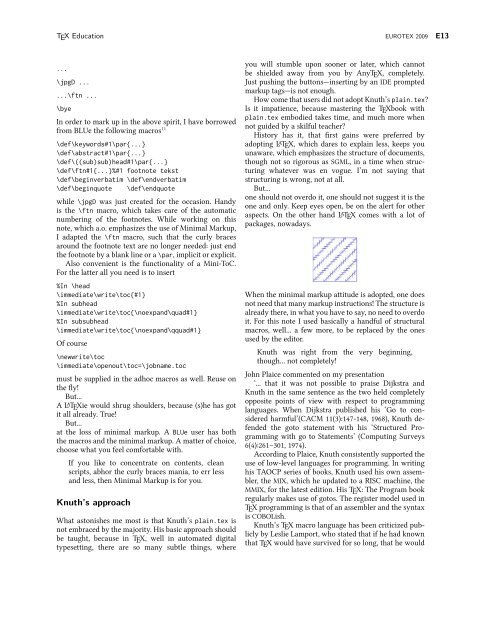Complete issue 30:3 as one pdf - TUG
Complete issue 30:3 as one pdf - TUG
Complete issue 30:3 as one pdf - TUG
Create successful ePaper yourself
Turn your PDF publications into a flip-book with our unique Google optimized e-Paper software.
TEX Education EUROTEX 2009 E13<br />
...<br />
\jpgD ...<br />
...\ftn ...<br />
\bye<br />
In order to mark up in the above spirit, I have borrowed<br />
from BLUe the followingmacros 11<br />
\def\keywords#1\par{...}<br />
\def\abstract#1\par{...}<br />
\def\((sub)sub)head#1\par{...}<br />
\def\ftn#1{...}%#1 footnote tekst<br />
\def\beginverbatim \def\endverbatim<br />
\def\beginquote \def\endquote<br />
while \jpgD w<strong>as</strong> just created for the occ<strong>as</strong>ion. Handy<br />
is the \ftn macro, which takes care of the automatic<br />
numbering of the footnotes. While working on this<br />
note,whicha.o.emph<strong>as</strong>izestheuseofMinimalMarkup,<br />
I adapted the \ftn macro, such that the curly braces<br />
around the footnote text are no longer needed: just end<br />
thefootnotebyablanklineora\par,implicitorexplicit.<br />
Also convenient is the functionality of a Mini-ToC.<br />
Forthe latter allyouneed isto insert<br />
%In \head<br />
\immediate\write\toc{#1}<br />
%In subhead<br />
\immediate\write\toc{\noexpand\quad#1}<br />
%In subsubhead<br />
\immediate\write\toc{\noexpand\qquad#1}<br />
Of course<br />
\newwrite\toc<br />
\immediate\openout\toc=\jobname.toc<br />
must be supplied in the adhoc macros <strong>as</strong> well. Reuse on<br />
the y!<br />
But...<br />
A L ATEXie would shrug shoulders, because (s)he h<strong>as</strong> got<br />
it allalready. True!<br />
But...<br />
at the loss of minimal markup. A BLUe user h<strong>as</strong> both<br />
themacrosandtheminimalmarkup.Amatterofchoice,<br />
choose whatyoufeel comfortablewith.<br />
If you like to concentrate on contents, clean<br />
scripts, abhor the curly braces mania, to err less<br />
andless,thenMinimal Markupisforyou.<br />
Knuth’s approach<br />
What <strong>as</strong>tonishes me most is that Knuth’s plain.tex is<br />
notembracedbythemajority.Hisb<strong>as</strong>icapproachshould<br />
be taught, because in TEX, well in automated digital<br />
typesetting, there are so many subtle things, where<br />
you will stumble upon so<strong>one</strong>r or later, which cannot<br />
be shielded away from you by AnyTEX, completely.<br />
Just pushing the buttons—inserting by an IDE prompted<br />
markuptags—isnot enough.<br />
HowcomethatusersdidnotadoptKnuth’splain.tex?<br />
Is it impatience, because m<strong>as</strong>tering the TEXbook with<br />
plain.tex embodied takes time, and much more when<br />
not guided by <strong>as</strong>kilfulteacher?<br />
History h<strong>as</strong> it, that rst gains were preferred by<br />
adopting L ATEX, which dares to explain less, keeps you<br />
unaware, which emph<strong>as</strong>izes the structure of documents,<br />
though not so rigorous <strong>as</strong> SGML, in a time when structuring<br />
whatever w<strong>as</strong> en vogue. I’m not saying that<br />
structuringiswrong, not at all.<br />
But...<br />
<strong>one</strong>shouldnotoverdoit,<strong>one</strong>shouldnotsuggestitisthe<br />
<strong>one</strong> and only. Keep eyes open, be on the alert for other<br />
<strong>as</strong>pects. On the other hand L ATEX comes with a lot of<br />
packages, nowadays.<br />
Whentheminimalmarkupattitudeisadopted,<strong>one</strong>does<br />
notneedthatmanymarkupinstructions!Thestructureis<br />
alreadythere,inwhatyouhavetosay,n<strong>one</strong>edtooverdo<br />
it. For this note I used b<strong>as</strong>ically a handful of structural<br />
macros, well... a few more, to be replaced by the <strong>one</strong>s<br />
used by the editor.<br />
Knuth w<strong>as</strong> right from the very beginning,<br />
though... not completely!<br />
JohnPlaice commented onmypresentation<br />
‘... that it w<strong>as</strong> not possible to praise Dijkstra and<br />
Knuth in the same sentence <strong>as</strong> the two held completely<br />
opposite points of view with respect to programming<br />
languages. When Dijkstra published his ‘Go to considered<br />
harmful’(CACM 11(3):147-148, 1968), Knuth defended<br />
the goto statement with his ‘Structured Programming<br />
with go to Statements’ (Computing Surveys<br />
6(4):261–<strong>30</strong>1, 1974).<br />
AccordingtoPlaice,Knuthconsistentlysupportedthe<br />
use of low-level languages for programming. In writing<br />
his TAOCP series of books, Knuth used his own <strong>as</strong>sembler,<br />
the MIX, which he updated to a RISC machine, the<br />
MMIX, for the latest edition. HisTEX: The Programbook<br />
regularlymakesuseofgotos.Theregistermodelusedin<br />
TEXprogrammingisthatofan<strong>as</strong>semblerandthesyntax<br />
is COBOLish.<br />
Knuth’s TEX macro language h<strong>as</strong> been criticized publiclybyLeslieLamport,whostatedthatifhehadknown<br />
thatTEXwouldhavesurvivedforsolong,thathewould

















